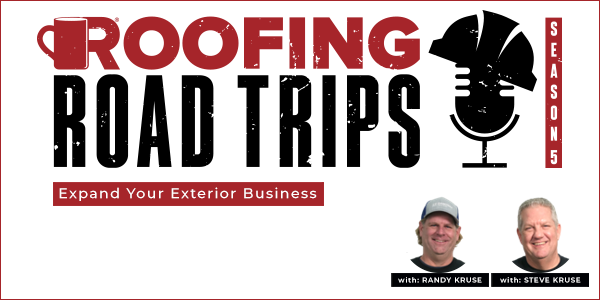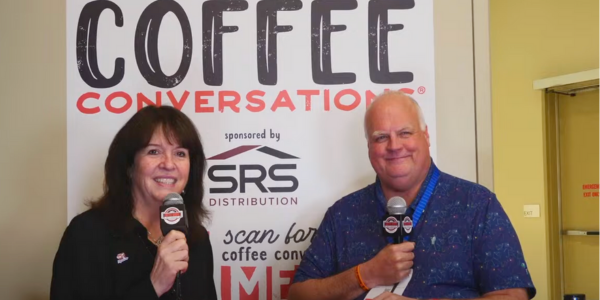Steve and Randy Kruse - Expand Your Exterior Business - PODCAST TRANSCRIPTION
September 28, 2023 at 12:00 p.m.Editor's note: The following is the transcript of a live interview with Randy Kruse and Steve Kruse from The Kruse Brothers. You can read the interview below or listen to the podcast.
Intro: Welcome to Roofing Road Trips with Heidi. Explore the roofing industry through the eyes of a long-term professional within the trade. Listen for insights, interviews and exciting news in the roofing industry today.
Heidi J. Ellsworth: Hello and welcome to another Roofing Road Trips from Roofers Coffee Shop. My name is Heidi Ellsworth, and today we're stepping down from the roof and we're going to check out the siding. The sides of the building and how you can add it to your business. We have the experts, the Kruse brothers, Steve and Randy Kruse, here to help us talk about how this all works. How can you expand your business to bring in siding? Gentlemen, welcome to the show.
Randy Kruse: Yeah, thanks for having us. My name is Randy Kruse. Actually got my start coming from the roof down to the siding, sides and joined on with my brothers.
Steve Kruse: Yeah, and I'm Steve Kruse. Thanks for having us. I've been in siding all my life, pretty much since I was 19 years old, so that's been a long time.
Randy Kruse: Except for the little bit when he taught me how to be a roofer and then he got back down and went back to siding, while I stayed on for the roof.
Heidi J. Ellsworth: You guys have been on the show before and you told this story, but I think you should just real quick tell the history, your business, the Kruse Brothers and what you're doing now, just so everybody knows. Go ahead and Randy, maybe start on how they kicked you up onto the roof.
Randy Kruse: Yeah, for sure. I had graduated from technical college and wanted to come down and join on with my brothers in their construction career, and they laughed. They said, "No, mom and dad sent you to college, so you need to stay there." I think they gave me probably the hardest job they could find, which was being up on the roof and I fell in love.
I mean, you get up there, you're by yourself, you're working along and you're in your own world, and I fell in love with it, so it backfired on them a little bit. It is a fun story to tell and talk about, but learning those flashing techniques does not come naturally. Being able to endure that labor, I needed my brothers to teach me the flashing techniques and water prevention and stuff like that.
Steve Kruse: Yeah, I think within our business, we always had roofing contracts, so we had contractors and some direct hire employees that would do our roofing, but we figured that if Randy wanted to be in construction, we're going to start him out on the hardest part of life, if you will, and taught him how to be a roofer. Well, he found out that working by the square and being a young man, you can make a pretty good living. He went to town and he was making some pretty good money and like he said, fell in love with the whole process.
Randy Kruse: I am the youngest of five, so when I did fall in love with it, they thought, "Oh, come on. Another one?"
Heidi J. Ellsworth: Steve, tell us about the business, how you and your brothers started the siding business. Give us the history of that.
Steve Kruse: Well, going all the way back to when I first started in the siding business, my older brother was working for a large siding company. Matter of fact, the two owners of the contracting business, they invented aluminum siding with US Steel.
Heidi J. Ellsworth: Wow.
Randy Kruse: It goes way back.
Steve Kruse: It goes way back. Those guys started in 1947. My brother or our brother, Bob, started in the siding business in 1975, and then I came along in '87 and then finished up college in '89 and then went full time. At that time, that company had 300 installers, so you needed to make sure that you were doing everything correct and you learn pretty quick when everyone's older than you. Then the business transitioned away from aluminum and into vinyl siding, and during that transition time, my brothers decided that they wanted to get away from working for someone else and own their own business, so established a pretty decent sized siding company from the working man's point of view.
Heidi J. Ellsworth: Nice.
Steve Kruse: It wasn't like we were always ever full-on owners that drove around in a super nice car and just dealt with salespeople. No, it wasn't like that. We always had our tools on, working with the installers. Even when the business got to be about 80 year round employees direct hire, I mean, 80 is a lot, and we still had to be out there working.
Then we evolved that from the installation side and doing siding and branched off into doing some roofing and some deck work and stuff like that and windows. Then, we decided that we wanted to go in more of a teaching role and that blossomed into what the Kruse Brothers is today teaching, taking that knowledge that we have, seeing things on the job site that are working and helping others from Oregon all the way to Pennsylvania. There are different install techniques, but it's all the same product and people are so intelligent in the installation community, and roofing, and siding, and windows that it works and we want to be able to let contractors know that we're there for them and we can help.
Heidi J. Ellsworth: Yeah. You were in the LP siding booth at IRE last year. You're going to be there again this year. You are ambassadors for that, so you really are able to bring all of that knowledge and expertise from LP to contractors all over the country.
Steve Kruse: Yeah, going all the way back to 2002, we were introduced to LP SmartSide and we installed our first house, fell in love with the material. Our installers loved working with an engineered wood, and we became pretty successful at the installation process. We were one of the first companies to have a project with a publicly traded national builder.
Heidi J. Ellsworth: Wow.
Steve Kruse: And then we've gone on and done well over a thousand houses, townhouses, assisted living buildings and things like that. That allowed us to also work with LP and make the installation videos as well as other things, such as being brand ambassadors.
Heidi J. Ellsworth: Yeah. That is awesome. With all that experience and everything you're doing today, what is some of your advice to roofing contractors, who want to get into the siding business, who want to add it to their business? What are some tips and tricks that you would recommend?
Randy Kruse: First and foremost, there's already a contract established when you're a roofing contractor. It always starts with sales products, what you take into the home, selling those products to that homeowner, very similar, writing up a contract that includes a warranty, your labor, your material, your profit overhead, all of that, very, very familiar or to both types of products. There's not any real surprises there.
Steve Kruse: Yeah, I think pitfalls may be that a roofing contractor sees so many different types of materials out there, and then the homeowner might throw them a curveball on something that they're not even aware of, and you might end up going down a rabbit hole. As a roofer has a specified brand to use, if are choosing and you're going to be become a sighting contractor, make sure that you choose a product and become knowledgeable about that product or those two products that you're going to offer, and then stick to your guns and know those products to offer that offer the homeowner in the same way that they would do with their roofing products.
Heidi J. Ellsworth: Right. Yeah. That makes total sense, because you really need to have... I mean, really a consultative sell of what's best and having your products and knowing what's out there already is the way to go no matter what you're doing, whether it's roofing or siding. A lot of roofing contractors out there already have this great list. They have clients from many years who they've done their roofs for them. How can contractors, once they decide to bring siding in, how can they go to their current customers or customers who they've done roofs for over the years and really get them involved with now more of the exteriors?
Randy Kruse: One of the things that contractors tend to do is they leave those homeowners... They finish the job and leave them alone out they go. Sometimes they're worried, "Oh, maybe that one didn't go so well, so I'm not going to contact them again. Or I wonder if they have any issues and maybe I don't want to stir that pot." But that establishes a contractor who can build on their legacy and be able to show their position in a community further down the road, send postcards back, email blasts, keep in contact with those homeowners.
So what, so they've got a little water leak. You just drop back and fix it. Maybe the siding is the cause of that water leak and it wasn't the roof all along. Now you can land a roofing job or a window job and be able to get that sidewall completed and just build on that referral list.
Steve Kruse: Yeah, I like either the email or the mailer itself where the Kruse brothers now do roofing, the Kruse Brothers now do siding and make it explosive, make it a big deal that you are building off your legacy as being the best roofing contractor. We now offer siding and windows and just that reminder, the constant contact with past and previous homeowners could generate quite a bit of business.
Randy Kruse: Let me build on that one second. I giggle a little because there's carpet and flooring contractor in this area that sells a lot of carpet and flooring. They now do windows and doors.
Steve Kruse: Oh, yeah.
Randy Kruse: If they can do it, anybody can do it.
Heidi J. Ellsworth: I love it. Well, and when you really think about that marketing, I mean market, what you're talking about of really working with current customers, it seems to me like working with your manufacturer will also really help because, I mean, when I think of somebody like LP SmartSide, they have beautiful marketing pieces and can help their contractors. They have great loyalty programs, so that can also help a roofing contractor by establishing that relationship with a good manufacturer to help get that word out to their customers.
Randy Kruse: Absolutely. I think, Steve, you want to talk about Remodeler's Edge?
Steve Kruse: Yeah, absolutely. The LP salespeople want to sell, so they want to help contractors and they do have lots of different literature to help you do that, but a lot of manufacturers also offer certifications and or trainings, and LP SmartSide has Remodeler's Edge. Remodeler's Edge not only will teach the contractor themselves on what products are and how to sell it, but they actually do installation training also.
You can have your salespeople be part of the training as well as the actual installers learning about the product and then learning how to install it. Along with that, once you go through the process, which is only a couple hour class, you then will receive a sales kit, which will help your salespeople or the owner, whoever it's going out and doing the sale. They will have all the tools they need to go out and be successful selling siding as well.
Randy Kruse: Then for the field personnel as well, the installers. LP has a technical team of people that can go out. They're bilingual, they can go out and they can help that first install go properly.
Steve Kruse: Yeah.
Randy Kruse: It really is learning about the product, learning about the literature, then getting the job, getting that contract signed and then getting that job ordered and shipped and then start the process of reside. I think when we go into reside and we look at preferred installers and certifications, whether it's roofing or siding, that's where that build can happen for a company to go next level, next step, broaden their contractor list or a contact list. Either one.
Heidi J. Ellsworth: Yeah, and then once you have a couple of successes, talk about it, get it out there, let them know you have these beautiful jobs out there that you just did and using your current customers and using that referral, we all know that's in the contracting world, that is it.
Randy Kruse: With those relatively low interest rates for homes that have been for the last many years, we think people are going to stay in their homes, they're going to want to remodel. At the same time, we know that there's not enough housing, so there's new construction as well. There's that play between new construction, back to remodel, where things are at in the housing industry. It's just super exciting.
Heidi J. Ellsworth: It really is. Steve, at the very beginning you talked about the pitfall of not knowing your products and going and going down that rabbit hole. I thought that was really interesting. What are some other pitfalls for the contractors, maybe too from the installation side, Randy, that you were talking about, but just the overall pitfalls that they should watch out for or avoid when they start adding siding to their business?
Randy Kruse: Siding in general falls within a couple different types of siding, clapboard siding, maybe it would be cedar, fiber cement or the best LV SmartSide, or there's also vinyl siding. There's a lot of components with vinyl siding and each product has their own nuances. I think some of those pitfalls would be that some people when they go in and think they're going to start doing siding as a part of their business is they try to do it all, "Oh, I can just order up cedar or I can just order up fiber cement. I can just order up SmartSide or vinyl." Hey, narrow that scope. Don't just jump in and think you can do all cladding. It doesn't have to be that way. You can be selective. We are selective that we only do LP SmartSide.
Heidi J. Ellsworth: Wow.
Steve Kruse: We have found that and a little bit of vinyl can't count that.
Randy Kruse: But we've decided that cedar, the cracking, the chipping and the maintenance, we just don't see the positive there. Then fiber cement as well. Similar things, cracking and chipping and the things that go with that. We don't want to put our homeowners through that. We stick with SmartSide. It's great for us to install, great for our installers to install. We know the product now and we know how to keep it simple.
Heidi J. Ellsworth: That makes a lot of sense. That makes sense. Just narrow in when you first get started and get your, it's like, I know this is totally different, but I'm always like, if you fly a lot, you pick your plane, right, you pick your airline, it's the same thing. What are some things, what's some wisdom you would share about starting a siding division? I mean, you have to put some business planning, not kind of, you need to do some business plans to bring that in as a division. What are some of your recommendations or wisdom?
Steve Kruse: Well, first of all, you need to have someone within your company or hire somebody that knows a little bit about citing itself, estimating. As Randy was talking about picking one or two product lines and sticking with those, that's very important. Then being able to estimate that the material and labor correctly, and then being able to hire the correct employees or subcontractors to do each one of those products.
We have citing contractors that install vinyl very, very well and very, very quickly. They're not exactly the guys that install LP SmartSide on a daily basis. To take them from vinyl and put them on SmartSide, they're going to be on that job a little bit longer. But then we have the exact opposite where our SmartSide guys don't want to do vinyl at all, so we don't even put them on a vinyl site. They're not really, the tools are very similar and the job is siding, however it is what we have found to be very effective is to have separate crews that occasionally can work together, but separate crews that do each one of these different sightings separately.
Heidi J. Ellsworth: Yeah.
Randy Kruse: I think also a roofing contractor, if they're smaller, they could start small. They can be selective with who they offer siding to when they're in selling the roof. If it's a small ranch style home and it looks like the fascia and soffit is in good shape, maybe they pop the gutters off and just do siding and they don't tackle that soffit and fascia right away. Maybe that's a way that they get into the groove of siding. Take it small, you know what you know, and that's roofing.
Jump into siding with the cheek walls of a dormer, the two sidewalls of dormers or the up and over or that real hard hit sunny side of a cedar home, reside that, offer that to the homeowner. They'll come around the corner and go, "Hey, wow, we can reside this wall with SmartSide and really make a difference and learn that siding, learn the trim around the windows, learn the corner posts. It doesn't have to be a big challenge.
Heidi J. Ellsworth: I love it. I love it. Okay, so let's take this one step further. We've been talking about siding, but you also mentioned earlier windows, doors. There's a lot of exterior that goes on with that. What if contractors are looking at, they're like, "Okay, well, we've got siding, but we also want windows and doors." What's some of your advice on really going to that full exterior offering?
Randy Kruse: Yeah. For me, it's going to be the exact same thing I think of how many window companies are out there, manufacturer products, pieces. You got to find ones that maybe have service that a manufacturer that can send out a service person if a latch were to break or something like that. Then again, narrow that scope, keep bringing it down to, okay, well we do X, Y, Z brand. That's really what we stand behind.
Steve Kruse: Yeah, when it comes to windows, once again, your installers of windows, the most effective guys are contractors that install windows on a daily basis. Having a subcontractor that does windows, especially replacement windows over a full replacement window or a frame replacement, having the trades that know how to do that. When it comes to, as Randy was mentioning, the brand of window and the type of window, make sure that you have a salesperson that you can work with work, because there are a lot of details.
Randy Kruse: A salesperson at the supply house.
Heidi J. Ellsworth: Yeah.
Randy Kruse: Those supply house salespeople are really our crutch that keeps us moving along.
Heidi J. Ellsworth: I'd love to hear that.
Steve Kruse: Right, with the different glass packages that are offered, grid patterns that are offered, I mean, even when you're talking about a replacement window versus nail flange windows, there are so many details that go into windows and doors, of course, that you need to make sure that you're ordering all of these products correctly because they're all special order and there's no going back. If you order them wrong, you own them and have to reorder. Taking that type of business flow and methodical is key to being successful in the window business.
Randy Kruse: Roofing has really done this already for us. If we go back to what you know is roofing, the manufacturers have given us their own brand of composite underlayment, their ice and water shield, their ridge venting. They've already done this for us. Keep it simple like that. Oh, and they've given us training and literature and everything to go in and successfully sell that job and install that job. Keep it simple like that. Keep it straight.
Heidi J. Ellsworth: Yeah. I think this is going to be the same answer, but I still have to ask it because I think it's really interesting since you all had a siding company and then added roofing, let's talk about that opposite direction. For all the siding companies out there right now that are listening to this and thinking, "We're seeing a lot of money in roofing, we should get into roofing." How hard is that and is it all the same thoughts or what do you think on that plane?
Randy Kruse: Boy, now you're talking real old school for us. Yeah, I mean, you started your career out as a sider. We hired some guys to come in and help us with the roofing. It was a large contract. It was a tear off on multifamily existing, so it was a remodel tear off, then reroof. We hired a group of guys that came in and helped us with those buildings, and we split up those buildings and we learned from them their techniques. We read a lot, love studying and the different specifications for different roofing and got that job completed.
Steve Kruse: Yeah, I think when we were adding added roofing to siding, the roofing guys will, contractors, they go in, they tear the roof off, they put their new flashings in and then typically they're putting the siding back together in a way that they know how to put it back together. Well, if we're going to be siding next or behind them. Obviously the roofing is going to go first. We needed to make sure that we were working with the roofing contractor to make sure that he was doing the things that we needed him to do to keep the house watertight, but not overdo it, such as caulking corner posts and re-nailing the siding to a specification because we're coming in and tearing it off.
Randy Kruse: Yeah.
Steve Kruse: We needed to make sure that the roofing contractor and the siding contractor are on the same page, and it'll actually make the roofer's job easier because he'll be able to expose areas to flash them properly without having the thought in his mind, "Oh, crap, I got to put all this back together and make it look nice."
Heidi J. Ellsworth: Yeah.
Steve Kruse: They're able to maybe pull that aluminum or vinyl outside corner off and put a roof to wall and a step flashing together on an outside corner and do that and do a really nice job and do it properly without the time it takes to put it back together. Once we got the contractors to work together like that, that really improved the amount of time on the job and the roofers were happy because they didn't have to do that finished work. The sighting guys just were happy that the flashing was done properly.
Randy Kruse: We get a lot of snow and ice here. We take our ice and water shield and we run it up our side walls, and we really keep that snow load idea into the scope of the work. Well, that affects the siding. That's what Steve's saying is, as a roofer, we were taking siding off and having to reinstall it. But if we are also doing the siding, we run that roofing up. As long as the top course of that ice and water shield when it rolls up the wall a little bit is waterproof, then when the sider gets there, then the sider's able to finish it up.
Heidi J. Ellsworth: Having that, really being looking at that full exterior can really help time savings and also quality. But I am also hearing from what you're saying is the importance of the relationships with other trades. If you are a roofer and you are not going into siding, it is still really important to have a great relationship with your siding contractors and/or if you're doing it all to really have the crews work together well, to understand that. Again, another important tip of relationships, and it always seems to come back down to that.
Randy Kruse: It absolutely does. As we talk about doing a full roof and a full siding job, that basically takes that house all the way back to the trim stage of when it was first built. One of the things that we do in remodel when we'd sit with our homeowners is we explain to them the amount of work and that we're going all the way back to basically a whole new project on your roof, a whole new project on the siding, it's major construction.
Heidi J. Ellsworth: Right.
Randy Kruse: Just because you don't see us out there with bulldozers and backhoes and we're not digging up there, what we're doing is a complete restoration of their exterior. You brought up windows and doors earlier. Well, you start throwing in windows, you need to orchestrate that with the siding people now.
Heidi J. Ellsworth: Right.
Randy Kruse: The siders are orchestrating that with the window people, and it does need proper scheduling. As Steve said, do the roof first, then the sider will follow in behind. Well, that comes down to good scheduling. As we talk about transitioning from one to the other, keep a good schedule, keep things straight, know where your special orders are and where it's coming from in your supply houses. That salesperson, you talked about, Steve, being able to get you your products when you need them.
Heidi J. Ellsworth: Great advice. Great advice. Okay. I want to wrap up this with just talking about continuing on this relationship thing. We've already talked about it quite a bit in here, but I would just love for you to share the importance of that relationship between the manufacturer, LP, and the contractor, and how much that means success in the end. Let's wrap up on that.
Randy Kruse: Yeah, I think we can talk about the relationship, relationship, what LP salespeople have done for us.
Steve Kruse: Yeah. Yes. From the very get go, we can go literally 20 years ago when we were first introduced to LP SmartSide, and we wanted to know everything there was about it, and our salesperson was able to bring us a piece, do a presentation and show us how it was made, where it was manufactured and really make us comfortable with what we were looking at, as well as having a technical team that could produce and show us installation processes and things like that.
Fast-forward to where we are today, the sales kits that LP provides, the training through Remodeler's Edge, the bilingual technical team that will actually come out to your job and not just stand around in some khaki pants and hand out some golf shirts.
Randy Kruse: Golf shirts.
Steve Kruse: These are guys that came from men and women that came from the field. They actually know what the products, what LP SmartSide is, and certainly the different textures. There's Shake, there's Board and Batten, there's Lap Siding. There are differences in the way those are installed and they have the product knowledge and all of that, the do's and don'ts of where to install it and where not to install it, and the general nuances of LP SmartSide.
The amount of literature and samples that are available as well are all things to make you successful. They want you to be successful. They partner with you through Remodeler's Edge, and there's lead generation as well through your salesperson and through Remodeler's Edge.
Heidi J. Ellsworth: I mean, I've been in the roofing now for quite a long time, and the overall construction and those relationships and really taking advantage and building a program with the content, the materials, the incentives, the loyalty programs, I think is just so important for a business. Thank you. Thank you both. Randy and Steve, thank you for being on this and for sharing your wisdom, as always is awesome.
Randy Kruse: Thank you very much. If I could add one thing before we go, if you get a chance to see us live and in person next week, we're going to be in Aurora, Colorado. We're going to be in the Denver market next week, and then within the same week we're going to be in Ohio doing a big hog roast as well.
Heidi J. Ellsworth: Fun.
Randy Kruse: We are, if you listen to this as a podcast months from now, we are always either in the shop doing virtual trainings. We're on the road someplace, check us out on our Instagram at the Kruse Brothers and follow us along. You might be able to get to see us live and in person and ask some of those important questions when you see us.
Heidi J. Ellsworth: I was just going to ask you, "Where can they follow, how can they follow you if they already or not?" @Kruserothers on Instagram is the main.
Randy Kruse: Absolutely.
Heidi J. Ellsworth: Perfect. Okay. You've heard it. You can also get this information on Roofers Coffee Shop, on the LP, on SmartSide directory, so you can get information there. Also past podcasts with Steve and Randy that have just been so great. Thank you again. Enjoy the Hog Roast. Sounds awesome. Also, I'm looking forward to seeing both of you in Las Vegas at IRE 2024.
Randy Kruse: Absolutely. We're excited.
Steve Kruse: Yeah.
Heidi J. Ellsworth: Okay, in the LP booth, check it out, everyone. We'll be seeing you there. Gentlemen, again, thank you so much for being here today.
Randy Kruse: Thank you for having us.
Steve Kruse: Yeah. Thank you.
Heidi J. Ellsworth: Thank you all for listening. Be sure to check out the LP SmartSide directory for all that information. We also have some great information on askaroofer.com, so be sure to check that out too. Also, check out all of our podcasts under the RLW navigation, under Roofing Road Trips, or on your favorite podcast channel. Be sure to subscribe and hit those notifications, so you don't miss a single episode. We'll see you next time on Roofing Road Trips.
Outro: Make sure to subscribe to our channel and leave a review. Thanks for listening. This has been Roofing Road Trips with Heidi from the Roofers Coffee Shop.























Comments
Leave a Reply
Have an account? Login to leave a comment!
Sign In